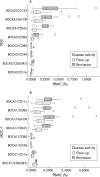Patients with active inflammatory bowel disease lack immature peripheral blood plasmacytoid and myeloid dendritic cells
- PMID: 15647187
- PMCID: PMC1774844
- DOI: 10.1136/gut.2004.040360
Patients with active inflammatory bowel disease lack immature peripheral blood plasmacytoid and myeloid dendritic cells
Abstract
Background: Breakdown of tolerance against the commensal microflora is believed to be a major factor in the pathogenesis of inflammatory bowel disease (IBD). Dendritic cells (DC) have been implicated in this process in various animal models, but data on human DC in IBD are very limited.
Aim: To characterise plasmacytoid DC (PDC) and myeloid DC (MDC) in patients with active versus inactive IBD and healthy controls.
Patients and methods: Peripheral blood was obtained from 106 patients (Crohn's disease (CD) n=49, ulcerative colitis (UC) n=57) and healthy controls (n=19). Disease activity was scored using the modified Truelove Witts (MTWSI) for UC and the Harvey Bradshaw severity indices (HBSI) for CD. Four colour flow cytometric analysis was used to identify, enumerate, and phenotype DC. DC from patients with acute flare ups and healthy controls were cultured and stimulated with CpG ODN 2006 or lipopolysaccharide (LPS).
Results: IBD patients in remission (PDC UC, 0.39%; CD, 0.35%; MDC-1 UC, 0.23%; CD, 0.22% of PBMC) have slightly lower numbers of circulating DC compared with healthy controls (PDC 0.41%, MDC-1 0.25% of PBMC). In acute flare ups IBD patients experience a significant drop of DC (PDC UC, 0.04%; CD, 0.11%; MDC-1 UC, 0.11%; CD, 0.14% of PBMC) that correlates with disease activity (correlation coefficients: PDC MTWSI, 0.93; HBSI, 0.79; MDC-1 MTWSI, 0.75; HBSI, 0.81). Moreover, both express alpha4beta7 integrin and display an immature phenotype. Freshly isolated PDC and MDC-1 from untreated flaring IBD patients express higher baseline levels of CD86 which increases further in culture and upon stimulation compared with healthy controls.
Conclusion: IBD patients lack immature blood DC during flare ups which possibly migrate to the gut. An aberrant response to microbial surrogate stimuli suggests a disturbed interaction with commensals.
Figures







References
-
- Langerhans P . Über die Nerven der menschlichen Haut. Virchows Arch Pathol Anat Physiol Klin Med 1868;44:325.
-
- Banchereau J , Briere F, Caux C, et al. Immunobiology of dendritic cells. Annu Rev Immunol 2000;18:767–811. - PubMed
-
- Banchereau J , Steinman R M. Dendritic cells and the control of immunity. Nature 1998;392:245–52. - PubMed
-
- Hornung V , Rothenfusser S, Britsch S, et al. Quantitative expression of toll-like receptor 1-10 mRNA in cellular subsets of human peripheral blood mononuclear cells and sensitivity to CpG oligodeoxynucleotides. J Immunol 2002;168:4531–7. - PubMed
-
- Krug A , Towarowski A, Britsch S, et al. Toll-like receptor expression reveals CpG DNA as a unique microbial stimulus for plasmacytoid dendritic cells which synergizes with CD40 ligand to induce high amounts of IL-12. Eur J Immunol 2001;31:3026–37. - PubMed
Publication types
MeSH terms
Substances
LinkOut - more resources
Full Text Sources
Other Literature Sources
Research Materials
Miscellaneous
